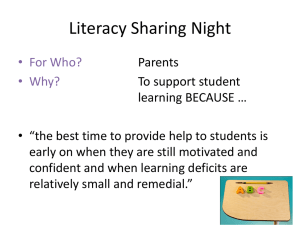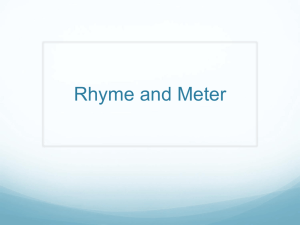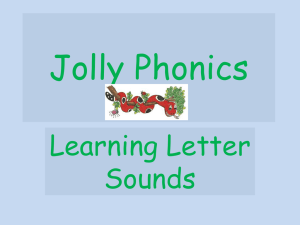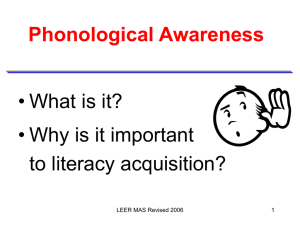ClassAct 2
advertisement
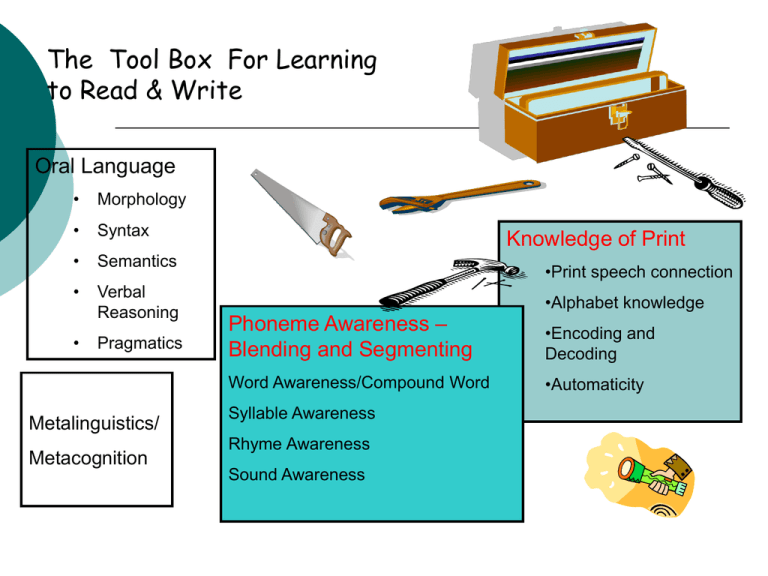
The Tool Box For Learning to Read & Write Oral Language • Morphology • Syntax • Semantics •Print speech connection • Verbal Reasoning •Alphabet knowledge • Pragmatics Knowledge of Print Phoneme Awareness – Blending and Segmenting Word Awareness/Compound Word Metalinguistics/ Metacognition Syllable Awareness Rhyme Awareness Sound Awareness •Encoding and Decoding •Automaticity Fluency – the ability to identify words accurately and read text quickly with good expression. (phoneme awareness is the foundation for building fluency.) Comprehension – ability to understand, reflect on, and learn from text … instruction builds on prior knowledge, language skills, and higher-level thinking Motivation – essential element for actively engaging children in reading process. The expectations for Grades 1 to 3 focus on the foundational knowledge and skills students need in order to establish a strong basis for language development. Including: oral language, prior knowledge, understanding of concepts about print, phonemic awareness, understanding of letter-sound relationships, vocabulary knowledge, semantic and syntactic awareness, higher-order thinking skills, and capacity for metacognition. Knowledge and Skills for Reading (page 14) According to research,, the knowledge and skills that children need in order to read with fluency and comprehension include: Oral language Prior Knowledge and experience Concepts about Print Phonemic Awareness Letter-Sound Relationships Vocabulary Semantics and Syntax Metacognition and Higher-Order Thinking Skills Interelated components that support and build on each other. Phonological awareness is known to be important for the development of later reading skills, and its lack is a powerful predictor of reading difficulties (Rayner, et.a. 2001) Students at risk lack phonemic awareness (National Reading Panel, 2001) Performance on PA highly related to development of reading fluency (Wagner, 1997 The ability to reflect on and manipulate chunks of sounds that are smaller than the word. Includes syllable awareness, rhyme, and phonemes. PA The highest predictor of reading success at the kindergarten and early grade one levels. NOTE: Most young children are sensitive to rhyme, and often like to play silly words games. Research has shown that children who rhyme by three years of age, and understand about phonemes between ages 4 and 6, become better readers. Metalinguistic Awareness Ease of Making Judgments and Corrections Content Semantics/Meaning/Words Easier Syntax/Sentence Grammar Morphology/Word Endings Harder Phonology /Sounds Is the conscious ability to reflect on and talk about the innate language skills we use. Progression of Phoneme Awareness / Print Awareness Word, letter, sound; segmenting sentences into words; recognizing print. Can use point as someone reads the words. Compound Words segmenting and deleting a part Syllables (beats in words); blending, segmenting and deleting Rhyme judgements and production First Sound recognition – beginning sound-symbol (if taught) “I l t” . “I like toast” Last sound recognition – continuing sound-symbol (especially consonant letter sound connections “I wt tt” – “I want toast.” Segmenting and deleting of first and then last sound (word families) “I can make man into mat.” Recognize differences in vowel sounds Segment short words as in c-ow (CV) and c-oa-t (CVC) into phonemes – represents written words with known alphabetic principles “kot for coat” Segment blends as in s-l-i-p (CCVC) or h-a-n-d (CVCC) Bottom Line for phonological awareness By the end of kindergarten students should be able to: 1. Name letters accurately and quickly; 2. Give associated sounds accurately and quickly. 3. Be able to segment and blend words with three sounds, like b-oo-k. 4. Be able to ‘have-a-go’ at spelling these words (including nonsense words). 5. Be able to ‘have’a’go’ at reading these words. Class Act Phonological Awareness Kit Overview of Cycles Cycle 1– Words 1.1 What is a Word, Sound and Letter 1.2 Which Word Doesn’t Belong 1.3 Which Word Doesn’t Belong -Print 1.4 Count the Words, Sounds and Letters Cycle 2– Compound Words 2.1 Two Words Make One 2.2 Picture This Compound Word 2.3 Take Away Compound Word Game Cycle 6– Last Sounds 6.1 Stop That Sound! 6.2 What’s That Sound? 6.3 What’s My Last Sound Puzzles 6.4 Listen to the End Cycle 7– First and Last Sounds 7.1 Heads or Tails? Cycle 3– Syllables Cycle 8– Phoneme Blending Cycle 4– Rhyming Cycle 9– Phoneme Segmenting 3.1 Colour Bear’s Drum for Syllables 3.2 Beat Panda’s Drum for Syllables 3.3 Take Away Syllable Game 4.1 Rhyme or No Rhyme? Game 4.2 Which Words Belong to Family 4.3 Which Word Doesn’t Rhyme 4.4 Rhyming Bingo 4.5 Draw a Rhyming Family 4.6 Who’s Driving—Make a Rhyme Cycle 5– First Sound/Alliteration 5.1 Which Word Doesn’t Belong 5.2 Alliterate the Food 5.3 What’s My Sound Puzzles 8.1 What Did I Say? Two Sound Words 8.2 What Did I Say? Three Sound Words 8.3 What Did I Say? Four Sound Words 9.1 Have-A-Go 9.2 Have-A-Go 9.3 Have-A-Go 9.4 Have-A-Go Sound Sounding Out—2 Sound Sounding Out—3 Sound Sounding Out—4 Sound Sounding Out—2,3,4 Cycle 10 – Have-A-Go 10.1 Have-A-Go Writing Words 10.2 Have-A-Go Zoo/Farm Animals 10.3 Have-A-Go Reading 10.4 Discover These Words! Class Act Phonological Awareness Kit Overview of Kit What is Phonological Awareness (PA): An area of oral language that relates to the ability to think about the ‘phonemes’ or sounds in words rather than just the meaning of the word. PA develops as an understanding of the structure of spoken language—that it is made up of words, words consist of syllables, rhymes and most significantly for the development of reading and writing, that words are made up of sounds. Why is Phonological Awareness Important: Research has consistently shown the very highest correlation between early developing phoneme awareness and success in learning the encoding and decoding skills of early reading and writing. Approximately 20% of students struggle with some aspects of PA, while another 8-10% exhibit significant delays. Early intervention can make a real difference to students with weak or limited PA. What is Class Act Phonological Awareness Kit: This kit is designed to help provide small group instruction for those students who present with weak phonological awareness skills. The kit’s activities are designed for students in kindergarten, early grade one, or those students still struggling in grades two or three. The complete kit contains 10 Cycles (see reverse), and these cycles are related to the hierarchy of developing PA. Cycle 10 is intended to help students extend their PA skills to the decoding and encoding process of reading and writing in Have-A-Go activities. How Do I use Class Act Phonological Awareness Kit: Students should be selected as early as possible for intervention. A ‘quick’ screen is available in each cycle’s package for diagnostic, and formative assessment. Use this screen to determine which Cycle to initiate intervention. For example, if a student can easily perform the tasks for Cycle 1 (Words) and Cycle 2 (Compound Words), but not Cycle 3 (Syllables) this is where you would start. You could then provide individual intervention, or include students who are at a similar level. Each Cycle contains a variety of file folder activities and the instructions to complete the activities are attached to outside of each file folder. Your school’s Speech/Language Pathologist is available for consultation on the appropriate use of this kit. Basics to Using the Class Act Kit Find students who did not meet K or Grade One expectations (as judged by Yopp-Singer, DRA, letter naming, teacher report, reported in formal assessments – SLP, Psych, etc.) Use Class Act Screen to determine pre-intervention data. (Your SLP can demonstrate the use with a student and help you determine starting cycle and intervention strategies.) DO NOT JUST START AT CYCLE ONE unless this is indicated. Place student in small group or provide individual help. K and Gr 1 Classroom teachers may be able to run small group if you help group the students. Your SLP can demonstrate an activity in the kit, or provide further strategies for those students who need more input. Be sure to track students, and collect post-intervention strategies. Intervention sessions should be between 10-20 minutes. LLI, Empower and Class Act Strong phonological awareness skills will support student success in reading programs such as Levelled Literacy Intervention in Grade 1 and Empower in Grade 2 Class Act programming should occur prior to and during reading interventions to support the student’s phonological awareness skills which are key foundations to further literacy skills. Student can be screened at any time starting in SK and early intervention start immediately. Students who enter grade 1 with weak reading skills and grade 2 students with continuing difficulties who have not completed the Class Act program, should be screened with the Class Act tool in the early fall and commence Class Act activities prior to LLI and Empower programming. Class Act activities can be run before these interventions begin or at the same time as the reading interventions.
